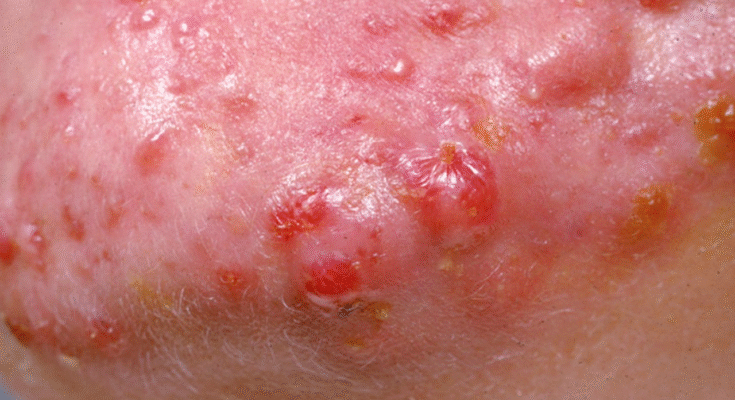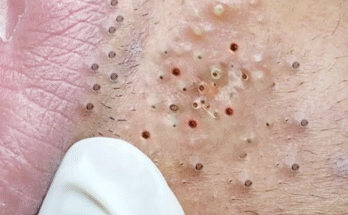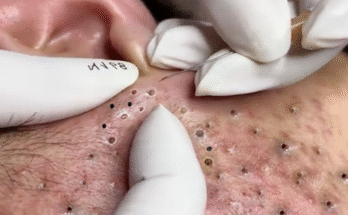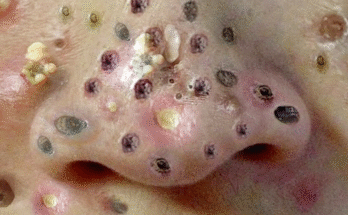Skin concerns can be confusing — especially when they look similar on the surface. Acne, rosacea, and milia are three of the most common conditions people struggle with, yet they are often misdiagnosed, mistreated, or misunderstood. Many people assume every bump is “acne,” but these conditions have different causes, triggers, treatments, and long-term implications.
Understanding which one you have is the first step toward clearer, calmer, healthier skin.
This comprehensive 5,000-word guide breaks down everything you need to know about acne, rosacea, and milia, including symptoms, root causes, common mistakes, and the most effective treatments — both at home and in dermatology clinics.
Let’s begin.
1. Understanding Acne, Rosacea, and Milia: Why They’re Often Confused
At first glance, all three conditions can present with redness, bumps, rough texture, and irritation. But the similarities end there.
Acne
A chronic inflammatory skin condition involving clogged pores, oil production, and bacteria. Results in pimples, blackheads, cysts.
Rosacea
A chronic inflammatory condition causing redness, flushing, visible blood vessels, and sometimes acne-like bumps — but no clogged pores.
Milia
Small, hard, white keratin-filled cysts trapped under the skin. Not related to inflammation, oil, or bacteria.
Misidentifying them can lead to:
-
Using the wrong products
-
Irritating the skin barrier
-
Worsening your symptoms
-
Delayed healing
This guide helps you differentiate each one clearly and treat them correctly.
——————-
SECTION 1: ACNE
——————-
2. What Is Acne?
Acne develops when oil glands and hair follicles become clogged, triggering inflammation and bacterial growth. It ranges from mild blackheads to severe cystic breakouts.
2.1 Types of Acne
1. Comedonal Acne
-
Blackheads
-
Whiteheads
-
Rough texture
Caused by clogged pores but not bacterial infection.
2. Inflammatory Acne
-
Papules
-
Pustules
Red, inflamed bumps.
3. Cystic/Nodular Acne
-
Deep, painful, swollen lumps
-
High scarring risk
-
Often hormonally influenced
4. Hormonal Acne
-
Deep cysts around the jaw/chin
-
Flares around menstrual cycles
-
Triggered by androgens
5. Fungal Acne (Malassezia Folliculitis)
-
Itchy, uniform bumps
-
Often on chest, back, or forehead
-
Worsens with sweat and oil
(Not true acne; yeast overgrowth.)
3. What Causes Acne?
Acne is multifactorial. The big four are:
1. Excess oil (sebum)
Stimulated by hormones, genetics, stress.
2. Clogged pores
Dead skin buildup traps oil.
3. Bacteria
C. acnes thrives in clogged pores.
4. Inflammation
Immune response creates redness and swelling.
Other contributors:
-
Stress
-
High-glycemic foods
-
Dairy
-
Heavy makeup
-
Humidity
-
Poor sleep
-
Harsh skincare
4. How to Treat Acne: The Complete Guide
Acne treatment depends on severity and skin type.
4.1 Proven Topical Ingredients
Salicylic Acid (BHA)
Deep cleans pores.
Benzoyl Peroxide
Kills bacteria.
Retinoids (retinol, adapalene, tretinoin)
Unclog pores, increase cell turnover.
Niacinamide
Reduces inflammation and oil.
Azelaic Acid
Brightens dark spots and reduces bacteria.
AHAs (glycolic, lactic, mandelic)
Exfoliate for smoother skin.
Sulfur
Absorbs oil and dries active pimples.
4.2 Oral Treatments
-
Antibiotics (short term)
-
Birth control pills
-
Spironolactone
-
Isotretinoin (Accutane)
4.3 Professional Treatments
-
Chemical peels
-
Microneedling
-
LED light therapy
-
Laser resurfacing
-
Cortisone injections (for cysts)
————————-
SECTION 2: ROSACEA
————————-
5. What Is Rosacea?
Rosacea is a chronic inflammatory condition primarily affecting the central face. Unlike acne, it isn’t caused by clogged pores or bacteria. Instead, rosacea involves vascular instability, hypersensitive skin, and abnormal immune reactions.
It’s often mistaken for acne because it can cause red bumps — but the underlying mechanisms are entirely different.
6. Types of Rosacea
Rosacea has four main subtypes:
1. Erythematotelangiectatic Rosacea (ETR)
-
Persistent redness
-
Visible blood vessels (telangiectasia)
-
Flushing
2. Papulopustular Rosacea (Acne Rosacea)
-
Red pimples
-
Swelling
-
Looks like acne but with no blackheads
3. Phymatous Rosacea
-
Thickened, bumpy skin
-
Most common in men
-
Can lead to bulbous nose (rhinophyma)
4. Ocular Rosacea
-
Dry, irritated eyes
-
Red eyelids
-
Grittiness
7. What Causes Rosacea?
Rosacea is complex and not fully understood, but contributing factors include:
1. Genetic predisposition
Runs in families; more common in people with fair skin.
2. Vascular hyperreactivity
Blood vessels dilate too easily, causing flushing.
3. Demodex mites
Higher densities found on rosacea skin.
4. Immune system overactivation
Inflammation and barrier dysfunction.
5. Skin sensitivity
Weakened skin barrier → irritation.
8. Rosacea Triggers
Rosacea flare-ups often follow predictable triggers:
Environmental
-
Sun exposure
-
Wind
-
Heat
-
Cold
Food & Drink
-
Alcohol (especially red wine)
-
Spicy foods
-
Hot drinks
Lifestyle
-
Stress
-
Exercise
-
Hot showers
Skincare Products
-
Strong acids
-
Alcohol-based toners
-
Fragrance
Understanding your triggers is critical for rosacea management.
9. How to Treat Rosacea
Because rosacea includes redness, bumps, and vascular issues, treatment is layered.
9.1 The Best Topical Treatments
Metronidazole
First-line rosacea treatment.
Azelaic Acid
Calms inflammation and redness.
Ivermectin Cream
Targets Demodex mites.
Brimonidine / Oxymetazoline
Constrains blood vessels (reduces redness temporarily).
9.2 Oral Medications
-
Low-dose doxycycline (anti-inflammatory)
-
Isotretinoin (severe cases)
9.3 Professional Treatments
Laser & Light Therapy
-
IPL (Intense Pulsed Light)
-
VBeam (Pulsed Dye Laser)
-
KTP lasers
These target blood vessels and reduce persistent redness.
————————-
SECTION 3: MILIA
————————-
10. What Is Milia?
Milia (plural of milium) are tiny white or yellowish bumps that form when keratin becomes trapped under the skin. They are not pimples, not caused by bacteria, and not inflammatory.
They are essentially micro-cysts.
Common areas:
-
Under the eyes
-
Cheeks
-
Forehead
-
Nose
-
Chest
11. Types of Milia
1. Primary Milia
Develop naturally — most common in adults and infants.
2. Secondary Milia
Form after skin trauma:
-
Burns
-
Blisters
-
Rashes
-
Excessive exfoliation
3. Milia en plaque
Clusters of milia on inflamed skin patches.
4. Neonatal Milia
Extremely common in newborns; resolves on its own.
12. What Causes Milia?
-
Dead skin trapped under the surface
-
Heavy creams
-
Occlusive products
-
Poor exfoliation
-
Sun damage
-
Genetics
Unlike acne, milia are not hormonal or bacterial — so acne treatments like benzoyl peroxide and salicylic acid won’t remove them.
13. How to Treat and Prevent Milia
13.1 Best Home Treatments
Gentle Chemical Exfoliation
-
Lactic acid
-
Mandelic acid
-
Low-strength retinoids
Avoid Heavy Oils
Choose non-comedogenic moisturizers.
Use Lightweight Sunscreen
Mineral sunscreens reduce long-term risk.
Warm Compresses
Help soften skin and allow natural shedding.
13.2 What NOT to Do
-
Do not squeeze milia
-
Do not pick or scratch
This can scar or cause infection.
13.3 Professional Removal
Dermatologists can extract milia using:
-
A sterile needle
-
A comedone extractor
-
Light electrocautery
-
Laser resurfacing (for chronic cases)
————————-
SECTION 4: HOW TO TELL WHICH ONE YOU HAVE
————————-
14. Acne vs. Rosacea vs. Milia: Quick Comparison Table
| Feature | Acne | Rosacea | Milia |
|---|---|---|---|
| Pores clogged? | Yes | No | No |
| Redness? | Sometimes | Always | No |
| Pustules/papules? | Yes | Yes | No |
| White bumps? | Yes (whiteheads) | Rare | Yes (hard) |
| Flushing? | No | Yes | No |
| Painful cysts? | Yes | Sometimes | No |
| Triggered by food, alcohol, heat? | Rare | Common | No |
| Feels sensitive? | Sometimes | Very | No |
| Treatment focus | Oil/bacteria | Redness & vessels | Exfoliation/extraction |
————————-
SECTION 5: SKINCARE ROUTINES FOR EACH CONDITION
————————-
15. Acne-Friendly Routine
Morning
-
Salicylic acid cleanser
-
Niacinamide
-
Lightweight moisturizer
-
Sunscreen
Night
-
Gentle cleanser
-
Retinoid
-
Moisturizer
16. Rosacea-Safe Routine
Morning
-
Gentle, non-foaming cleanser
-
Azelaic acid
-
Soothing moisturizer (ceramides)
-
Mineral sunscreen
Night
-
Gentle cleanser
-
Metronidazole or ivermectin (prescription)
-
Moisturizer
17. Milia Prevention Routine
Morning
-
Gentle cleanser
-
Lightweight moisturizer
-
SPF 30–50
Night
-
Mild chemical exfoliant (2–3× weekly)
-
Retinoid (1–2× weekly)
-
Eye cream that is non-heavy/non-occlusive
————————-
SECTION 6: HOLISTIC MANAGEMENT AND LIFESTYLE
————————-
18. Diet & Lifestyle for Clear Skin
Acne
-
Reduce dairy
-
Lower sugar intake
-
Increase omega-3s
Rosacea
-
Avoid triggers: alcohol, spicy foods, hot drinks
-
Manage stress
-
Keep the face cool
Milia
-
Avoid heavy creams
-
Wear sunscreen daily
19. When to See a Dermatologist
Seek help when:
-
Acne is cystic or scarring
-
Rosacea is worsening
-
Milia keep returning
-
Products burn or irritate your skin
-
Over-the-counter options aren’t working
20. Final Thoughts: Understanding Your Skin Is the Key to Healing
Acne, rosacea, and milia may all show up as bumps on the skin, but they are completely different conditions — each with its own triggers, symptoms, challenges, and treatments. Once you understand which one you have, you can treat it correctly and efficiently.
Clear, healthy skin doesn’t come from guessing.
It comes from education, patience, consistency, and using the right ingredients for your condition.
You now have a comprehensive guide to help you make informed decisions — and begin your journey to calmer, clearer, more confident skin.



